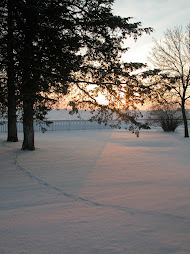An old house makes a lot of noise in the winter. The wood that keeps our roof overhead is almost 120 years old and thus when touched by extreme cold, the result is all sorts of creaking and popping sounds – each one reminding me to be grateful I’m indoors on a night when the temperature slipped below zero.
I’m also grateful that two stories below my bed, down in the scary cellar, a twentieth century marvel – a forced air propane furnace – continues to pump warm air throughout the spacious rooms of this prairie box. It’s an old farmhouse but it’s fairly cozy even though the windows are often so iced over you can’t catch a clear view of outside.
As I ponder the creaks overhead, I wonder about the people who’ve lived in this house throughout its history. Who pulled the woodstove out from the middle of the dining room and patched the hole in the ceiling? What year did the bathroom go in? Who decided to run the floor boards in the hallway upstairs in two different directions? Who replaced the long narrow windows with short ones and who decided the bedrooms at the front needed only one window instead of their original two? And, who set the house facing the road instead of overlooking the lake?
I can only venture a guess at these questions, of course. Who can know the past unless someone in the present takes the time to write up the details of domestic life and then takes further action to save it. Maybe someone once did this; maybe the history of this house sits in someone’s attic in Orange, California. How could I know?
The stories of the past link one generation to the next. In a way, they keep the past alive. This is important for many reasons, the very least of which is waking up grateful your heat comes from the basement instead of wood stove in the middle of the dining room.
08 December 2007
Subscribe to:
Post Comments (Atom)






No comments:
Post a Comment